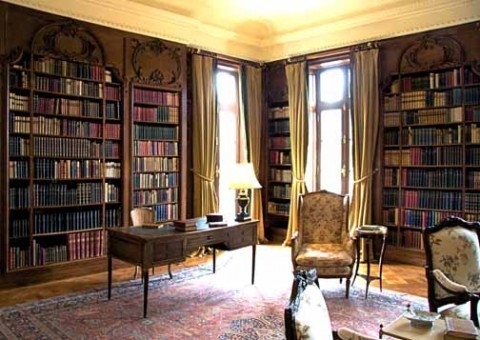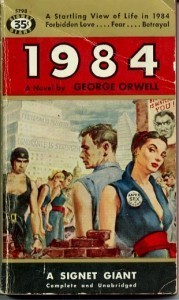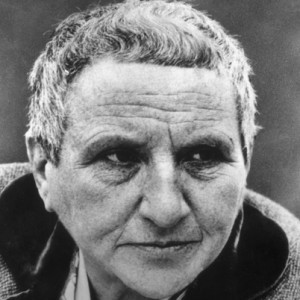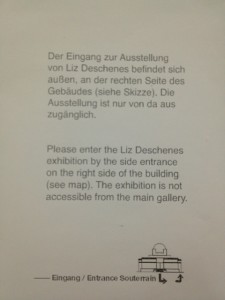The Paris Review's Blog, page 853
January 24, 2013
On the Occasion of her 151st
Edith Wharton by Design
People who live in New York might agree that there is very little reason to find yourself between Fourteenth and Forty-Second Streets unless you absolutely have to. Go past Union Square, and you’re liable to bump into everything from confused tourists to people selling knockoff Louis Vuitton and Fendi bags worse than the ones you can purchase on Canal Street in Chinatown. The twenties into the thirties can look like a never-ending row of scaffolding at certain stretches, with C-grade delis and fast food chains hidden beneath, leading you finally to the terrifyingly bright lights of Times Square.
For the better part of the decade in which I’ve lived in New York, this experience is probably what has kept me from the middle of the city. But when I moved from Brooklyn into Manhattan, and started taking daily walks up the various avenues from the West Village to an office on Twenty-Eighth, I began to learn the history of certain buildings I passed along my way: admiring the townhouse at 28 E. Twentieth Street where President Theodore Roosevelt was born; the splendor and history of Gramercy Park; the row of buildings in the Flower District that seems unremarkable, until you realize that this block of Twenty-Eighth between Fifth and Sixth was once known as Tin Pan Alley, and filled the American Songbook. With each block, the twenties became more and more magical, especially on the days when I managed to avoid the crowds scuttling down the sidewalks—those less hectic New York days when I could look up and admire the various gargoyles and the golden dome of the Sohmer Piano Building. The architecture of the twenties distracted me from my daily grind, but it was on an evening trip to the grocery store that the area I once shunned suddenly took on an entirely new meaning. That night I noticed the red plaque on a doorway next to a Starbucks at 14 W. Twenty-Third Street that read, “This was the childhood home of Edith Jones Wharton, one of America’s most important authors.” Read More »
Orwell at the BBC, and Other News
It was all the rage! On the eighteenth-century literary vogue for suicides.
“It’s pretty much all hopeless,” and other advice on writing a memoir. (Personally, I would say: throw in a few recipes.)
1984 has never been dramatized by BBC Radio 4 before now. Why? Maybe this has something to do with it: “Orwell partly based the book’s torture area, Room 101, on a meeting room in the building he remembered from his time at the BBC.”
“The day will come when there’ll be private publishing houses in the Soviet Union.” A previously unpublished interview with Joseph Brodsky.
January 23, 2013
Offsides, Part 1
 Mirko Vučinić showed up to the first day of soccer season this summer with a mustache. It was a thin one, and it made him look like a character out of an Italian neorealist homage to the dignity of the working class—handsome and proud, and heroic because ultimately he is up against forces that are far too great for him to succeed. Vučinić is the starting striker for Juventus, Italy’s Serie A defending champion. To date, though, he may be most famous for dropping his shorts, placing them on his head, and running around the pitch in his underwear after he scored a goal in an international match against Switzerland in 2010. You likely wouldn’t see that in an Italian neorealist film. But that’s all right, because Vučinić isn’t Italian. He’s Montenegrin, and Montenegro has a story of its own.
Mirko Vučinić showed up to the first day of soccer season this summer with a mustache. It was a thin one, and it made him look like a character out of an Italian neorealist homage to the dignity of the working class—handsome and proud, and heroic because ultimately he is up against forces that are far too great for him to succeed. Vučinić is the starting striker for Juventus, Italy’s Serie A defending champion. To date, though, he may be most famous for dropping his shorts, placing them on his head, and running around the pitch in his underwear after he scored a goal in an international match against Switzerland in 2010. You likely wouldn’t see that in an Italian neorealist film. But that’s all right, because Vučinić isn’t Italian. He’s Montenegrin, and Montenegro has a story of its own.
The country, once a part of the former Yugoslavia, is one of the tiniest in all of Europe. Incredibly, its population of 657,000—about the size of Baltimore’s—is the same as the number of registered soccer players in Poland, Montenegro’s first opponent in its 2014 World Cup qualifying campaign, which began in September. In order to automatically qualify for the World Cup, Montenegro has to finish first in its group of six, or make it to a playoff match and finish second. The team’s other opponents in the group include Ukraine, whose population of forty-five million is a mere seventy times larger than Montenegro’s, and England, whose team is ranked sixth in the world and is the group favorite. Read More »
What Do We Have In Our Pockets?
Author Etgar Keret and journalist and editor Dov Alfon have started a new intiative called storyvid, an attempt to create the literary equivalent of a music video. We bring you storyvid's first production, a four-minute pilot based on Keret’s story “What Do We Have In Our Pockets?” Goran Dukić of Wristcutters: A Love Story (also based on a Keret story) directs. The short was selected to screen in the 2013 Sundance Film Festival, which runs through the end of this week.
Caveat Emptor
I was at Moe’s Books in Berkeley looking for material on seventeenth-century shape poems with my not-yet-two-year-old daughter when a wizened man with mutton chops spotted me reshelving the books she was piling in the corner.
“What are you looking for?” he asked.
I quickly learned that he’d spent his entire scholarly life immersed in the study of shape poems. Moe’s must be rich with encounters like this; it’s a four-story bookstore just three blocks from the University of California, Berkeley campus.
He told me about a contemporaneous vogue for something called emblem books. Perhaps the best known emblem book is Hans Holbein the Younger’s beautifully decorated The Dance of Death, in which woodcuts of various scenes and settings depict a skeleton reminding us of time’s wicked work on our health and aspirations. Beneath each woodcut is an epigram in verse. The best-known English practitioners of emblem books, Francis Quarles and George Wither, are hardly known at all, possibly because it’s hard to anthologize poems that are incomplete without an accompanying picture. Read More »
Gertrude Stein, Monster Hunter, and Other News
Gertrude Stein, Gelatinous Cube Wrangler, and other possible monster hunters.
The Brazilian government has allotted $35 million dollars toward promoting their literature internationally. Amazon’s fingerprints can be found, if one is of a suspicious frame of mind.
“Some years ago, I found myself, to my surprise, the victim of a campaign of malicious e-mail stalking and online defamation by a former M.F.A. student.” We’ve heard of M.F.enemies, but one man’s tale takes the cake.
“There are a lot of books out there that there is no particular reason on Earth why money should have been spent on them.” Barbara Meade, the longtime owner of Politics and Prose Bookstore, is retiring, and reflects on a life in books.
January 22, 2013
“Wait While I Get the Feeling …”
Seceding: A Conversation with Liz Deschenes
On a typically snowy January morning in Vienna, I visited the famed Secession to see an exhibition by New York–based artist Liz Deschenes. For many years her work has articulated a materialist stance; rather than taking pictures of things in the world, Deschenes usually works sans camera, turning to the inner life of photography and proposing discursive questions about its philosophical, scientific, and experimental possibilities. Deschenes has recently called her approach “stereographic,” a term originally coined in the 1850s for two nearly identical prints that are paired and viewed through a stereoscope to produce a 3-D illusion of a single image. Deschenes employs this operation of doubling and dividing to give the viewer a chance to actively participate in her work, and it also places an emphasis on the constantly changing nature of her recent photographs.
As soon as I stripped off my coat and sweater at the museum, I learned that I needed to exit, since Deschenes had chosen a rarely used side door outside the building as the entrance to her show. Bringing my attention even more crisply to the Secession’s unique architecture, this unusual parcours led to a so-called “viewfinder,” a small empty hallway before two other rooms that (stereographically) forked to the left and right. Inside these chambers Deschenes had installed a series of moonlight-exposed photograms—Stereograph #1–#16, 2012—long and lean silver-toned planks, which she coupled to form four sets in each room. The energetic spaces formed within these brackets reframed and isolated—as one does when taking a picture—the spaces, and they offered an atmosphere for contemplation and concentration. In turn, the photograms themselves were still developing—oxidizing in situ and already bearing the traces of their time spent in the Secession’s lower gallery.
In an interview in the show’s catalogue, Deschenes notes, “The reference is cameras as rooms. ‘Camera’ literally means ‘room’ in Latin.” More specifically, it comes from the Ancient Greek καμάρα, or “kamara,” anything with an arched cover. Curious to learn more about her installation in this vaulted chamber, as well as the ways in which she feels each piece is never really “finished,” I asked her a few questions from frosty Vienna about the show. The exhibition is on view at the Secession until February 10, 2013.
These photograms began in Vermont, by being exposed by the night sky. Do you prefer to work nocturnally?
I worked at night for purely practical reasons. Simply put, the paper I used for these pieces is light sensitive, so working during the day—no matter how sunny or cloudy—would overexpose the paper.
What was it like to install in the Secession? Take us through a little bit of the process of putting the show together in the space.
Secession, as you mentioned, has a rather esteemed history. In response to the building I wanted to reframe the spaces and the entry point. By doing so, the order of the spaces was thus altered. Bettina Spörr, the curator, was instrumental to this project—amongst other significant contributions, she managed to convey, in only a twenty-four-hour site visit, the dynamism and unique artistic opportunity that sums up Vienna’s Secession. I always make scale models for the projects too, and lately, I’ve made models of the photographs at a one-to-one scale, so that I can get a better sense of the final works in space.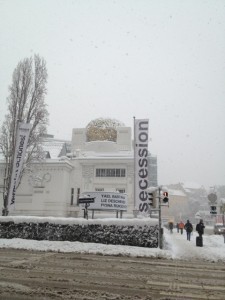
You have some upcoming shows, in London at Campoli Presti and in New York at Miguel Abreu Gallery. Will Stereograph #1–#16 be presented again soon elsewhere? Will the installation change, or be “finished,” if so?
I’ve decided not to reconfigure these works in new venues. As for the works being finished, I’m reminded of the title of Johanna Burton’s essay for Secession’s catalogue, which was drawn from something I said in an interview recently. I was asked about my relation to Henri Cartier-Bresson’s notion of the decisive moment and in response I said that in my work, “There is no decisive moment.”
But actually, there are so many decisive moments, and their effect is cumulative. Sometimes decisions are altered or changed entirely—for instance, I thought this work could travel to London, but it will not. Instead, I'll make new pieces that will respond to that site in more specific ways that are yet to be determined.
Stereographic vision activates the viewer, making one more aware of the constantly changing work in the gallery. It seems like this perception could also extend outside of the gallery, too. Is that something you aim for?
Yes—and I’d like to take on other venues too, not just galleries and museums. I don’t have an ideal site, though I like the idea of the work being installed at unexpected places, like when On Kawara’s work was installed in an elementary school classroom.
You’re deeply engaged with photography, but there’s also a painterly and sculptural aspect to your work. Still, I wonder if light is really your medium. Do these works represent light, or is it more that they are light?
The work reflects or absorbs light, certainly. I’m hoping that they simultaneously suggest other ways of viewing, even if the shift is barely perceptible in the moments of viewing.
Arthur Miller on The Crucible
Today marks the sixtieth anniversary of the premiere of The Crucible. In this interview, Arthur Miller discusses the writing of the play, and the McCarthy hearings that inspired it.
The Paris Review's Blog
- The Paris Review's profile
- 305 followers



